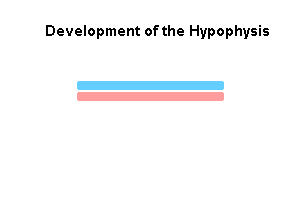Pituitary
 The pituitary, or hypophysis, is really two distinct glands.
The pituitary, or hypophysis, is really two distinct glands.
- The anterior pituitary, also called the adenohypophysis.
- The posterior pituitary, also called the neurohypophysis.
Both parts are attached by the pituitary stalk to the median eminence at the base of the hypothalamus.
- Pituitary adenomas may be "benign" (i.e., not malignant) but can nevertheless cause significant problems either from excess hormone production or from mass effect (e.g., crowding the optic chiasm). For illustration, see WebPath.
The anterior pituitary is of ectodermal origin (from Rathke's pouch). The anterior pituitary has the character of an epithelial gland, hence the alternative name of adenohypophysis. Adeno- means gland.
Cells of the anterior pituitary form loosely organized clumps and cords associated with a vascular plexus. Blood enters this plexus through portal vessels that come through the stalk from the hypothalamus. Thus the secretory activity of adenohypophyseal cells can be efficiently controlled by hormones secreted in very small amounts from nearby hypothalamic neurons.
Several different cell types, secreting several different hormones (GH, ACTH, FSH, LH, TSH), occur in the anterior pituitary. Anterior pituitary cells also differ markedly in staining properties, giving rise to the names acidophils, basophils, and chromophobes. However, these staining characteristics seem to be more reflective of metabolic condition or some other quality than of hormone identity, so that functional identification of these cells is best accomplished with specialized immunohistochemical techniques. [More, from WebPath.]
The pars intermedia, a portion of the adenohypophysis adjacent to the neurohypophysis, may contain colloid-filled, epithelially-lined follicles. Its function, if any, is obscure.
The posterior pituitary is nervous tissue, hence the name neurohypophysis. It originates as an outgrowth from the diencephalic region that will become the hypothalamus.
The neurohypophysis consists of the terminals of axons extending down through the stalk from cell bodies in the hypothalamus. It also contains numerous glia cells (sometimes called "pituicytes"). [More, from WebPath.]
The secretory processes of the posterior pituitary secrete oxytocin and antidiuretic hormone (ADH, vasopressin).
The anatomical and vascular relationships of the pituitary to the hypothalamus are quite significant.
The pituitary is attached by its stalk to the median eminence at the base of the hypothalamus, between the optic chiasm and the mammillary bodies. The stalk has three major elements:
- Axons from hypothalamic neurons whose terminals comprise the neurohypophysis.
- The pars tuberalis of the adenophysis, essentially an extension of the anterior pituitary upward and around the bundle of neurohypophyseal axons.
- Hypophyseal portal vessels which transport regulatory factors from the hypothalamus to the adenohypophysis.
Hypophyseal portal veins enable efficient regulation by hypothalamic neurons of the secretory activities of anterior pituitary cells. Releasing or inhibiting factors secreted by hypothalamic neurons diffuse into hypothalamic capillaries and are then carried through the hypophyseal portal veins into the vascular network of anterior pituitary.


